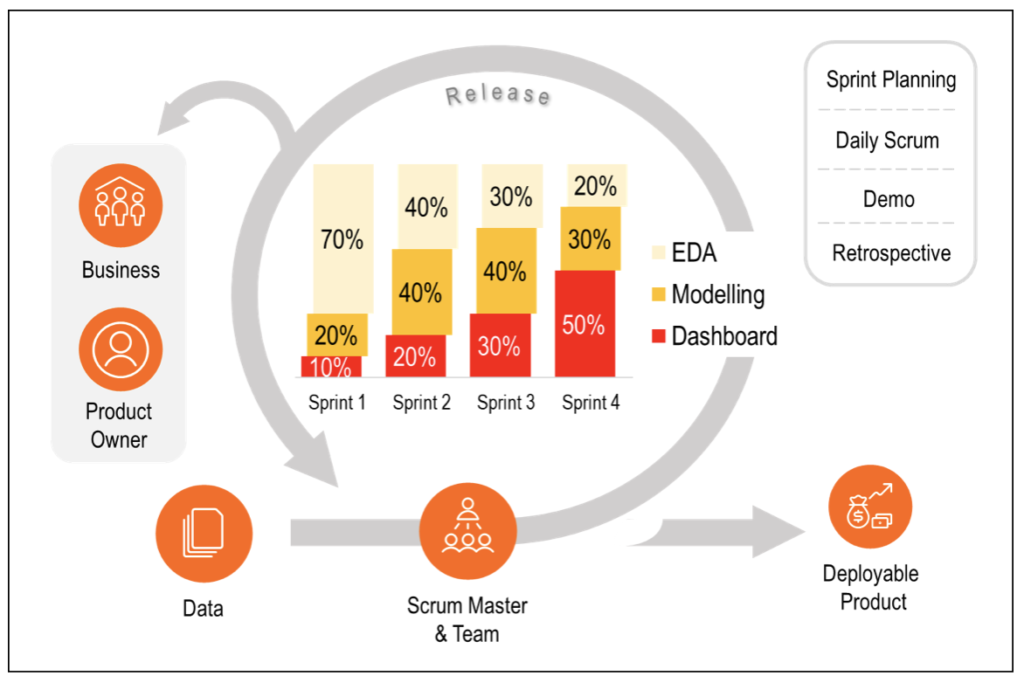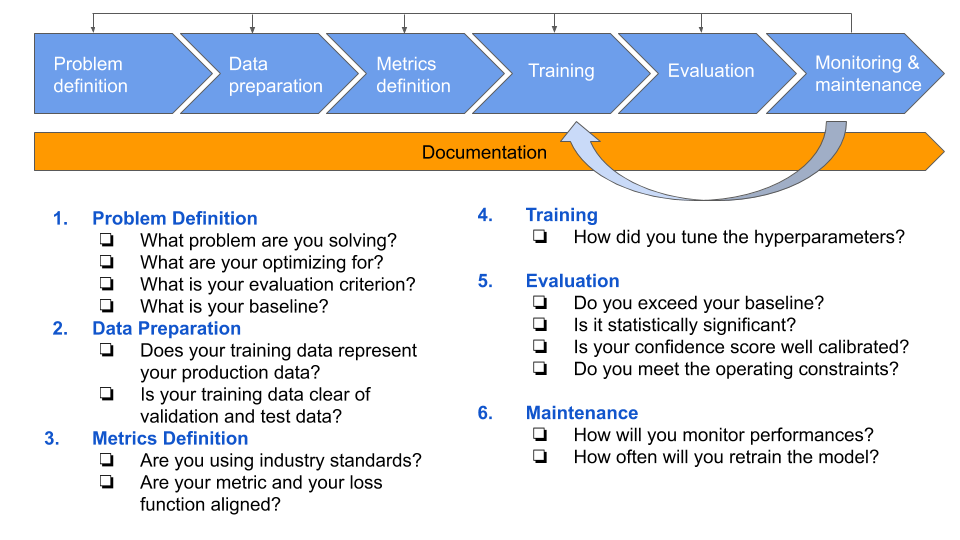
AI And Scrum
AI And Scrum
In today’s rapidly advancing world, artificial intelligence has become a crucial component for organisations seeking to stay ahead of the competition. As businesses turn to machine learning to gain an edge, they are also recognising the importance of efficient and effective AI labs. Speak to MCTC today about our consultancy advice and training packages.
Introduction
Artificial Intelligence (AI) has become a crucial part of today’s technological advancements, with organisations using it to gain a competitive edge in various industries. As the demand for AI increases, so does the need for efficient development practices to manage and deliver AI projects effectively. In this article, we will explore the benefits of using Scrum in AI development and how it can help organisations create AI systems with speed, adaptability, and quality.
Understanding Artificial Intelligence
Definition of Artificial Intelligence
Artificial Intelligence refers to the ability of machines or systems to mimic human intelligence and perform tasks that typically require human intelligence. AI systems can analyse data, recognise patterns, make decisions, and adapt based on new information.
Importance of AI in today’s world
AI has revolutionised industries such as healthcare, finance, transportation, and manufacturing. It enables organisations to automate tasks, improve decision-making, enhance customer experiences, and optimise business operations. Organisations that leverage AI can gain significant competitive advantages, boosting efficiency, productivity, and innovation.
Types of AI applications
AI applications can be categorised into three types: narrow AI, general AI, and super-intelligent AI. Narrow AI focuses on specific tasks, such as voice assistants, recommendation systems, and image recognition. General AI refers to systems capable of performing human-like tasks across various domains. Super-intelligent AI surpasses human intelligence and is purely hypothetical at this stage.
Challenges in AI Development
Complexity of AI projects
AI projects involve intricate algorithms, large datasets, and complex models. Developing AI systems requires expertise in machine learning, data science, and software engineering. Managing the complexity of AI projects can be challenging, as it involves continuous research, experimentation, and optimisation.
Managing timelines and resources
AI projects often have uncertain requirements and evolving scopes. Balancing project timelines and allocating resources can be difficult, especially when working with changing priorities and dynamic datasets. Traditional project management approaches may not be agile enough to handle the iterative and adaptive nature of AI development.
Maintaining a high level of quality
AI systems need to be accurate, reliable, and secure. Achieving high-quality standards in AI development involves rigorous testing, validation, and monitoring. Ensuring the reliability and ethics of AI systems is crucial, as even small errors or biases can have significant real-world implications.
Introduction to Scrum
Definition of Scrum
Scrum is an Agile project management framework that emphasises collaboration, iterative development, and continuous improvement. It provides a structured approach to managing complex projects by breaking them into smaller, manageable units called sprints. Scrum promotes transparency, adaptability, and customer engagement throughout the development process.
Key principles of Scrum
Scrum is built on several key principles, including:
- Empirical Process Control: Scrum embraces uncertainty and encourages teams to inspect and adapt their work continuously based on feedback and empirical data.
- Self-Organising Teams: Scrum promotes self-organising cross-functional teams that can collectively take ownership of the project and make informed decisions.
- Iterative Development: Scrum divides work into short iterations called sprints, allowing for regular feedback, incremental development, and early value delivery.
Benefits of using Scrum in software development
Scrum offers several advantages in software development, including:
- Improved Productivity: By breaking down work into smaller, manageable tasks, Scrum enables teams to deliver valuable increments of the product within short iterations, boosting productivity.
- Enhanced Collaboration: Scrum promotes collaborative work environments, fostering effective communication and engagement among team members, stakeholders, and customers.
- Increased Adaptability: Through regular sprint reviews and retrospectives, Scrum allows for quick adaptation to changing requirements, market conditions, and customer needs.

This image is property of editor.analyticsvidhya.com.
Scrum in Agile Methodology
Overview of Agile methodology
Agile is a software development methodology that values flexibility, collaboration, and customer satisfaction. It focuses on iterative and incremental delivery, placing emphasis on individuals and interactions rather than rigid processes and documentation.
How Scrum fits into Agile
Scrum is one of the most widely used frameworks within Agile methodologies. It offers a practical and scalable approach to Agile, providing a set of rules, roles, and ceremonies that facilitate successful project delivery. Scrum embodies the core principles of Agile, such as iterative development, continuous feedback, and self-organising teams.
Why Agile is suitable for AI projects
AI projects often involve evolving requirements, uncertain outcomes, and changing data. Agile methodologies, including Scrum, are well-suited for AI development due to their ability to handle complexity, allow for iterative improvement, and embrace changing requirements. Agile provides a flexible framework that can accommodate the dynamic nature of AI projects.
Scrum Framework
Roles and responsibilities in Scrum
Scrum defines three primary roles: Product Owner, Scrum Master, and Development Team. The Product Owner is responsible for defining and prioritising project requirements, ensuring the team delivers value to the customer. The Scrum Master acts as a facilitator, coach, and servant leader, ensuring the team adheres to Scrum principles and removes any impediments. The Development Team is responsible for delivering the product increment, collaborating, and continuously improving.
Scrum artefacts and their purposes
Scrum utilises four main artefacts to facilitate project transparency and progress tracking: Product Backlog, Sprint Backlog, Increment, and Burn down Chart. The Product Backlog is a prioritised list of features and requirements, serving as the project’s backlog. The Sprint Backlog defines the work committed to during a sprint. The Increment is the sum of all completed and tested work at the end of a sprint. The Burn down Chart tracks the team’s progress throughout the sprint.
Scrum events and their importance
Scrum includes a set of time-boxed events to ensure regular updates, feedback, and progress. These events include Sprint Planning, Daily Scrum, Sprint Review, and Sprint Retrospective. Sprint Planning defines the work to be completed in the upcoming sprint. The Daily Scrum is a short daily meeting where the team synchronises their work and plans for the day. The Sprint Review involves showcasing the accomplished work to stakeholders. The Sprint Retrospective is a team reflection and improvement session.

This image is property of i.ytimg.com.
Applying Scrum to AI Development
Adapting Scrum for AI projects
While Scrum is primarily used in software development, it can be adapted for AI projects through modifications in the process and practices. AI-specific tasks, such as data collection, model training, and experimentation, can be included in sprint backlogs. Teams can adopt AI-specific tools and techniques, such as Python libraries for machine learning or cloud platforms for data processing, to enable efficient AI development within the Scrum framework.
Scrum practices for efficient AI development
Several Scrum practices can enhance the efficiency of AI development:
- Backlog Refinement: Regularly refining the AI project’s Product Backlog helps identify and prioritise data requirements, algorithm improvements, and model optimisation tasks.
- Sprint Reviews with Stakeholders: Involving stakeholders in sprint reviews provides valuable feedback and ensures the AI system aligns with their expectations and needs.
- Continuous Integration and Testing: Implementing automated testing and continuous integration practices helps maintain the quality of AI systems and catch potential issues early.
Managing AI research and experimentation
AI projects often involve research, experimentation, and exploration of new algorithms and technologies. Scrum can facilitate managing AI research by including dedicated sprints for research and experimentation. These sprints allow teams to explore new possibilities, validate hypotheses, and iterate on models or algorithms. Research findings and insights can then be incorporated into subsequent development sprints for continuous improvement.
Benefits of Scrum in AI Development
Increased transparency and collaboration
Scrum fosters transparency by providing visibility into the project’s progress, priorities, and challenges. Through regular Scrum events and artefacts, team members, stakeholders, and customers gain insight into the AI development process. This transparency enables better collaboration, effective communication, and shared decision-making, leading to improved outcomes.
Flexibility to adapt to changing requirements
AI projects often face evolving requirements and dynamic datasets. Scrum’s iterative and adaptive nature allows teams to respond and adapt quickly to changing requirements. Regular sprint planning, reviews, and retrospectives provide opportunities to review and prioritise work, ensuring the most valuable features and improvements are delivered within the given constraints.
Ability to deliver value at a faster pace
Scrum’s focus on iterative development allows for faster delivery of valuable increments. By breaking down work into sprints and working collaboratively, AI teams can deliver functioning AI systems at a faster pace. Each sprint delivers a potentially releasable increment, enabling organisations to derive value from the AI system early on and make informed decisions based on real-world usage and feedback.

This image is property of tech.ebayinc.com.
Case Studies: Scrum in AI
Example 1: Implementing Scrum in an AI startup
An AI startup, aiming to develop a recommendation system, implemented Scrum to manage its AI development. By utilising Scrum, the team successfully prioritised and executed features, leveraged customer feedback through regular sprint reviews, and iteratively improved the recommendation algorithm. The startup was able to deliver a fully functional recommendation system within a short time frame, gaining a competitive edge in the market.
Example 2: Scrum adoption in a large AI research organisation
A large AI research organisation introduced Scrum to streamline its research and development efforts. By adopting Scrum, the organisation improved collaboration between research teams and development teams, enabling more efficient knowledge sharing and fast-tracking the integration of research findings into production systems. The organisation experienced a significant reduction in time-to-market for new AI solutions.
Example 3: Successful AI project using Scrum
A healthcare organisation used Scrum to develop an AI-powered diagnostic tool. The organisation leveraged Scrum to collaborate with medical experts, collect and annotate relevant data, and train the diagnostic algorithm iteratively. The Scrum framework helped the organisation manage uncertainty, refine requirements based on feedback from physicians, and ensure the tool’s accuracy and reliability. As a result, the organisation successfully deployed the diagnostic tool, improving patient outcomes and reducing diagnosis time.
Conclusion
AI development is a complex and rapidly evolving process, requiring specialised expertise, adaptability, and efficient project management. Scrum provides a robust framework for managing AI projects, enabling organisations to overcome challenges, deliver value at a faster pace, and ensure high-quality AI systems. By embracing Scrum’s principles, practices, and artefacts, organisations can harness the power of Agile methodologies to create innovative AI solutions and stay ahead in today’s competitive landscape.
